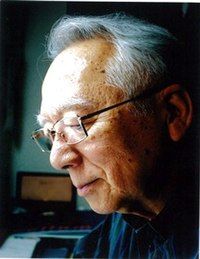The solo piano music of Joji Yuasa includes representative works from all four of the major phases of his career. The first phase, covering roughly the first half of the 1950s, was a time of apprenticeship for Yuasa. Representative works from this period are the Two Pastorales (1952), Three Score Set (1953), and Chant pour “Do” (1954). During this time Yuasa absorbed musical influences from a variety of modern Western composers while developing a personal aesthetic in which aspects of modern Western philosophy—Sartre especially—were combined with ideas drawn from traditional Japanese art forms. Japanese culture was in the process of reconstituting itself after the difficult experience of World War II, and could not provide its young composers with teachers who were able to guide them in successfully combining modern Western techniques with traditional Japanese aesthetics. In response to this problem, a group of progressive young Japanese composers—including Yuasa and Takemitsu—decided to work collectively toward the formation of a modern Japanese style in music and in the visual arts. This collective, which lasted from 1951 to 1957, called itself Jikken Kobo (Experimental Workshop). Among the activities of Jikken Kobo were performances of works by major Western modernist composers, such as Bartók, Schoenberg, and Messiaen, as well as of works by the group’s members. It is largely from these performances, and from the study of scores and contemporary musical treatises, that Yuasa derived his musical influences and began to forge a personal style.
The only work by Yuasa from the Jikken Kobo period that was not for solo piano was his Projection for seven instruments (1955). This chamber work was the first of his works to incorporate the techniques of twelve-tone composition, which he learned through studying René Leibowitz’s Schoenberg and His School and Ernst Krenek’s Studies in Counterpoint Based on the Twelve-Tone Technique. His next piano work, Cosmos Haptic (1957), which was simultaneously the last work of the Jikken Kobo period and the first work of his early maturity, contains a few twelve-tone aggregates but its principal harmonic structure derives from two symmetrical eight-note pitch-class collections. Both collections are among the modes of limited transposition described by Messiaen in his Technique of My Musical Language, which was another treatise that was popular among the members of Jikken Kobo. Yuasa returned whole-heartedly to twelve-tone composition in the next piano work of his early maturity, Projection Topologic (1959). Common to both Projections and to Cosmos Haptic is a desire to fuse the slow, fluid sense of time characteristic of the music of the traditional Noh theater with the harmonic resources made available by modern Western music. The success of this fusion in Cosmos Haptic and in Projection Topologic helped to establish Yuasa as one of the most important Japanese composers of his generation.
In the 1960s and 70s, Yuasa broadened the range of his influences and compositional techniques, largely as a result of his work in electroacoustic composition. His 1974 article, “The Shadow of Tape Music on Instrumental Music,” is representative of his thinking during this period. The article provides several examples in which techniques that are idiomatic to the electroacoustic domain—special effects involving resonance, the decomposition of complex sounds into their individual components and, conversely, the fusion of individual sound events into clusters—found their way into his compositions for voices and acoustic instruments written between 1961 and 1974. One of the article’s most frequently cited works is On the Keyboard (1972), which includes gestures and resonance effects inspired by electroacoustic composition along with the use of chance procedures, the latter being used to select the intervals in some of the work’s rapidly articulated passages. Unpredictability is also a general feature of the work’s musical surface, which contains rapid shifts in register and figuration, frequently punctuated by rests of varying duration. Despite the elements of discontinuity and unpredictability in its structure, On the Keyboard succeeds in projecting a clear sense of dramatic unity.
While the 1960s and 70s may be characterized as a period of middle maturity in Yuasa’s output, the works from 1980 fall within a long, late mature period that comprises approximately half of his compositional career. Some differences in style are discernible within this period, but in general this phase is marked by a synthesis of the style of his works from the late 1950s—notable for its fusion of traditional Japanese aesthetics with harmonic materials influenced by Western modernism—and the ambitious “internationalist” style of the 1960s and 70s. Among the signature works of this period are several inspired by major literary figures from Japanese history, such as Scenes from Basho for orchestra (1981-9) and Toward the “Midnight Sun”: Homage to Ze-Ami for piano and tape (1984). One of the major works from this period, and possibly Yuasa’s greatest work for solo piano, is Cosmos Haptic II: Transfiguration (1986). Because of the synthesis of older and newer styles that it demonstrates, it is fitting that this is the first work since the original Cosmos Haptic from 1957 to re-use that title. Like the earlier Cosmos Haptic, Cosmos Haptic II contains passages that combine stillness with great intensity of dramatic expression, but the harmonic palette has been enriched by the frequent inclusion of all twelve chromatic pitch classes. In some passages, the twelve tones have been distributed over a two-octave range, thus forming “modes” through which the composer moves freely. In taking this approach to twelve-tone composition, Yuasa has succeeded in converting a concept that originated as an expression of linear time—the succession of individual pitch classes in a strictly ordered temporal sequence—into a “space” that effectively filters the available pitch material, thus converting spans of registral space into richly resonant harmonic spectra.
The two-octave twelve-tone sets, which were first introduced in 1980 in Scenes from Basho, have become one of Yuasa’s signature compositional techniques ever since. In addition to their appearance in Cosmos Haptic II, they are prominent in Subliminal Hey J. (1990) and in Melodies (1997). In Subliminal Hey J. they are intertwined with fragmentary (and therefore “subliminal”) quotes of the melody from the Beatles song, “Hey Jude,” and in Melodies they appear alongside musical ciphers of the names B-A-C-H, B-R-A-H-M-S, and F-R-A-N-Z S-C-H-U-B-E-R-T. The ciphers use both the German note names and the French solfège system in order to spell out the composer’s names. 1997, the date of the composition, was the 200th anniversary of Schubert’s birth and the 100th anniversary of Brahms’s death. The cipher for B-A-C-H was presumably included because of its frequent appearance in other composer’s works following Bach’s own use of it in the Art of Fugue.
Melodies is the end point—at least for now—of Yuasa’s music for solo piano. Following the strong assertion of his musical identity in works such as Cosmos Haptic, Projection Topologic, On the Keyboard, and Cosmos Haptic II, the later works find Yuasa, as at the beginning of his career, reflecting upon his relationship to the legacy of Western concert music. Perhaps his renewed interest in this question—posed even more poignantly in Subliminal Hey J. and in Melodies than in the works from the early 1950s—may signal the beginning of a significant new phase in his compositional development.
REFERENCES
Burt, Peter. 2001. The Music of Toru Takemitsu. Cambridge and New York: Cambridge University Press.
Galliano, Luciana. 1993. “The Music of Joji Yuasa.” Sonus—Contemporary Music Materials (SCMM), Special Issue 1993: 76-88.
Kushida, Mari. 1998. “Noh Influences in the Piano music of Joji Yuasa.” DMA Thesis, University of Illinois at Urbana-Champaign. Ann Arbor, Michigan: UMI.
Yuasa, Joji. 1987. “The Shadow of Tape Music on Instrumental Music.” Contemporary Music Review 1/2: 53-74.
———. 1989. “Music as a Reflection of a Composer’s Cosmology.” Perspectives of New Music 27/2: 176-97.
——— and Roger Reynolds. 1993. “A Jostled Silence (Part Three).” Perspectives of New Music 31/2: 172-228.




Reviews